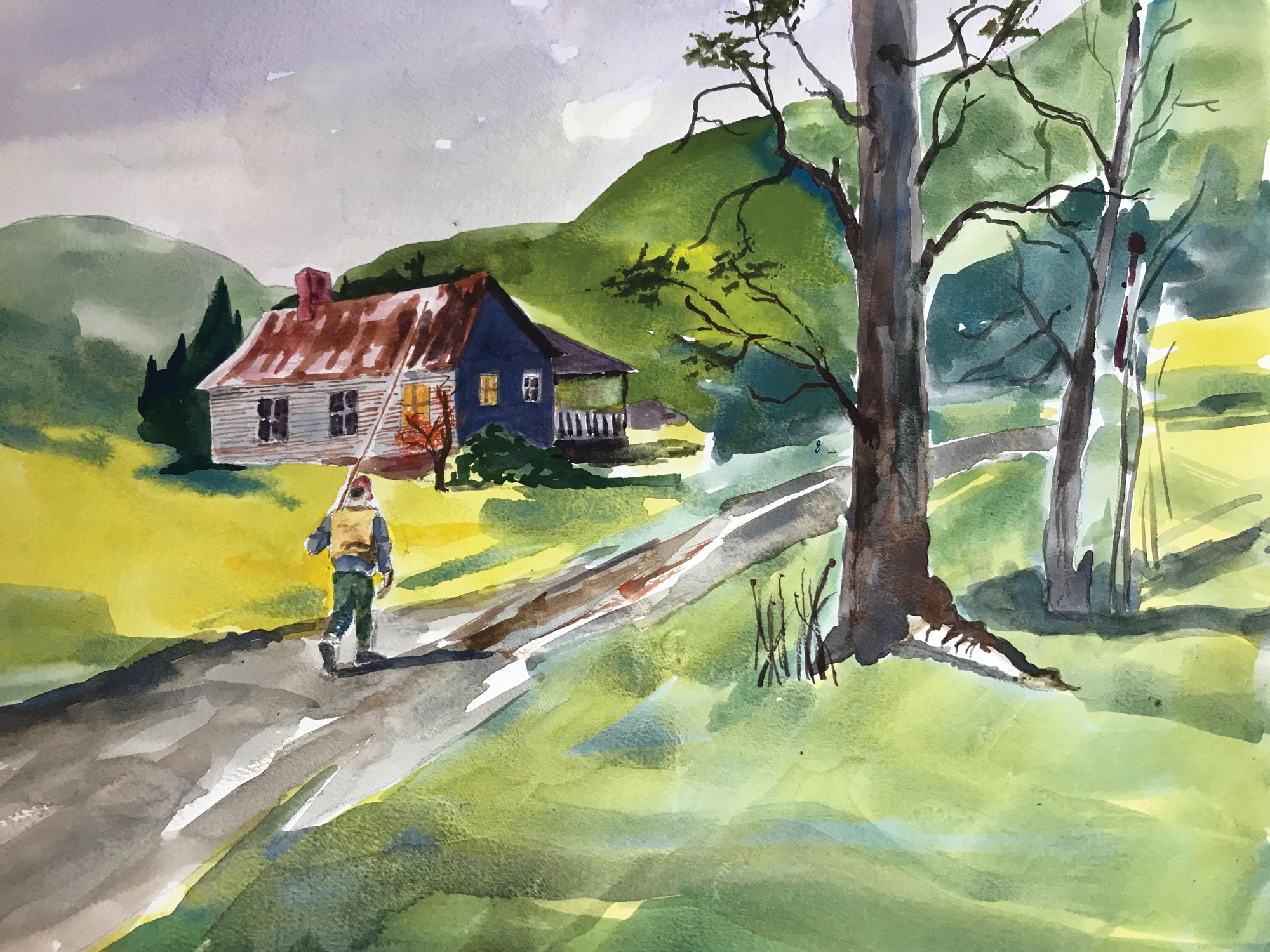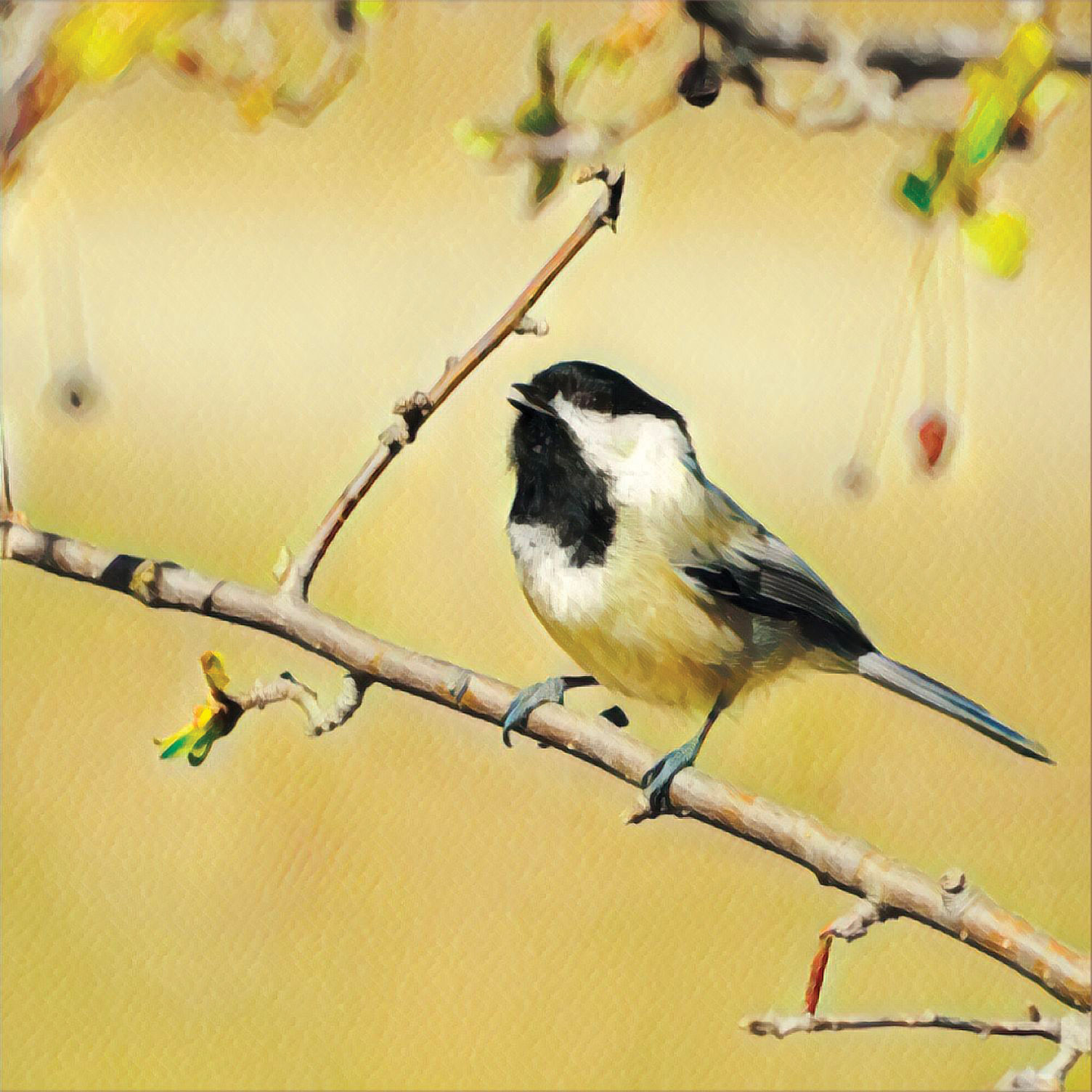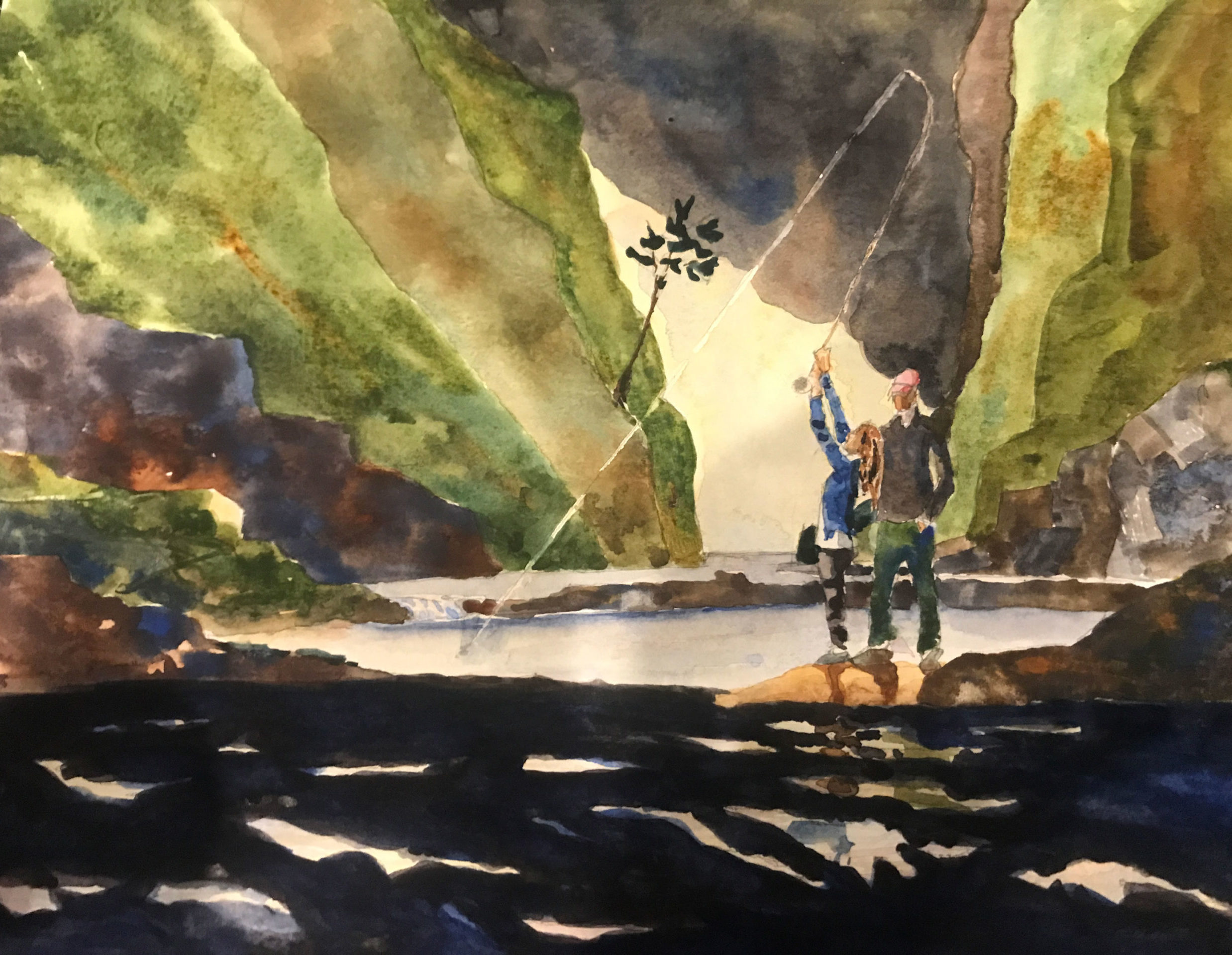by Jody Martin
I let the truck coast to a stop a couple of hundred yards uphill from the cabin, rolling onto a wide muddy area on the side of the winding drive matted with leaves wet from last night’s rain. It gives me a safe distance from which to climb slowly out of the truck, let the door close without banging, and make my way quietly on down the hill.
I always try to be quiet in case she is sleeping. The front steps, faded and worn, creak badly, so I avoid them and creep slowly around to the side window to look in on her. The dogwood tree seems a little closer to the window since last time, and I have to duck under its branches to see her.
She knows I am there. No matter how quietly I approach, she always knows I am there. It’s not a look of recognition, just a slight tilting of the head that lets me know she has somehow heard me arrive, or maybe it’s a smell, a change in air pressure, a premonition, I really don’t know. But she knows. I’ve read that sometimes when some of your sensory perception is lost, other senses can kick in, compensate. Maybe that’s what’s going on. She’s stretched out on the wood floor, paper scattered about her. Her left hand, the good one, is making slow, lazy circles on a large piece of paper with one of the oversized pencils I gave her last time. The patterns she makes are curious, sometimes circular, sometimes ellipses, occasionally with angles and with other components that might be figures, or might not. I have several of them hanging above my desk, convinced that there is something here that she is trying to say. But I could be mistaken. Her other arm is curled under her, almost as if it’s a cushion giving her support as she sprawls on the oak floor while she sketches. Or like it’s something she is trying to hide.
She is waiting. I could continue watching, and if I did, she would continue with her slow sketching, head tilted slightly so that her left ear is closest to the window where I stand. It’s a game we have played before. Always, she waits.
I return to the front of the cabin, walk up the three wooden steps, cross the porch and knock lightly. Amy answers the door, and it’s clear that although Marcia knew I was here, Amy did not. She has forgotten how to smile, years ago, but she nods and turns by way of inviting me inside. I wipe my boots on the mat and step in, consciously avoiding looking around at the dilapidated and drab furniture, the dinginess. I walk to the doorway of the room where she is sketching.
“Ready, Marcia?” I say. Her name is pronounced Mar-see-ah, and not Marsha, I have been corrected, although not by her. She stands slowly, head still tilted, and walks slowly toward me, past me, out the front door and down the wooden steps, her eyes pointed elsewhere while her feet travel a path she knows by heart. I look around to catch Amy’s eye to let her know we are leaving, but she has retreated to some far corner of the cabin.
I walk outside where Marcia has her face turned upward toward the sun. I think she enjoys this feeling, but it also brings on slight fasciculations that I do not understand and want to stop, so I interrupt her. “OK then, let’s go!” I say, and I reach down to take her hand. I try for the right hand, the crippled one, thinking that the more I try to move and exercise that hand and arm the better they will be, so that they do not continue to atrophy. Dupuytren’s contracture or possibly sclerodactyly we’ve been told, but nobody seems to know for sure. As I reach for her right hand she sidesteps, moving around to my right side, so that my right hand will hold her left, the good one, as we walk toward the creek. I switch the fly rod to my left hand to accommodate this. I brought the 3-weight today, a sensitive little rod that I think might fit her small hand better than the 4-weight I have been bringing.
I talk nearly constantly as we walk, knowing she will not respond, but thinking she might appreciate the sound of my voice, the change in her routine. I talk about the day, the creek, the fish we might catch, the drive up into these hills, even my job, mostly just filling the silence between us. Marcia seems to know the path well, and she sometimes picks up her feet to step over rocks before I even mention them. How she does this I do not know. “Big log ahead,” I say, and she stops and puts out a foot to feel for it before stepping over it. I think she could find her way down to the creek and back now without me.
The half mile path is slightly overgrown, and I guide her around stinging nettles and some plants that look a little like poison oak. Closer to the creek the path widens and merges with a narrow sandy bank, bathed in the pale green light that filters down through the canopy. Simon’s pool looks perfect, and I am thankful for that. The green-black slow section of water is the result of a small cataract that spills through a tight juncture of rhododendron and laurel before opening into a wide spot that is maybe 4 feet deep in the center, 8 feet across, with a shallow tailout over a wide bed of small, smooth stones that have been carved and sculpted by Appalachian waters since long before the time of Jesus. There have been days when we caught nothing here, and she has never expressed disappointment, but when the water is right and the trout are cooperative the miracles are unfettered and fall about us like star drops, catching in her gray eyes.
I explain to her what I am doing as I string the rod and tie on a small drab size 18 nymph and pinch on a tiny split shot. Her head is tilted and I know she is listening, but whether to me or to the odd voices of the pine siskins above us I am not sure. They are not always here, the little siskins, and I wonder if she realizes that as she listens. We’ve heard all sorts of birds back in these thickets, and I always stop to tell her what each one is if I know. Several times we’ve heard wild turkeys, and a few times even owls, the dark blue-green shadows of the mountain fooling them into thinking that night was already here. The chickadees are my favorites, but they are not here today.
I flip the line out into the middle of the pool, and as the nymph starts to sink the take is immediate, as it nearly always is. These small trout do not see artificial flies often and they are hungry and eager. There is no need to set the hook; the trout has turned its head toward home and done this for us. I say, “OK, here we go!” and hand her the rod, placing it in her good hand. And now the first miracle occurs. She has the rod in her left hand, and I know she feels the trout on the other end, the tremble, the vibrancy of life desperately trying to break free. The rod quivers, and as it does, she starts to pull the handle of the rod toward her other hand, at the same time that she moves the hand toward the rod, until both of her hands are wrapped around the cork. And at this precise moment she has two working hands, equals; she is complete. The fish has just enough power to move the rod, sending its life force down into the warm cork handle where Marcia’s fingers are clasped. The rod bounces, vibrates, and Marcia’s arms tremble, and there is a connection here, a lifeline, Marcia on one end, a small brook trout on the other, the great mystery borne of pain in between. I don’t want to tire the trout out too much, so I say, “OK, let’s give this one a break,” and I take the rod from her and pull the fish into my net. I guide her left hand down to the net so that she can feel it. But I forget to watch where her feet are going and she steps into the water, getting her small tennis shoe and sock wet on that foot. She does not seem to notice, even though the water here is icy cold. She touches the trout, and her head is tilted to the side and has a look of concentration on it. We let the fish slip back into the pool. “Want to try for another one?” I ask, but she does not reply.
We catch three more before the second miracle occurs. This one I can never count on. There have been days when it happens on the first trout, and days when it never happens at all despite catching more than a dozen. I cannot predict it and do not understand it. But for whatever reason, today it happens, and it happens on the fifth trout. As always, I hand her the rod, and she moves it so that both hands can feel the pull, the tremble, the desperation, both hands working together, miracle number one. But now comes the change. Something is different. This trout, this small glossy arc of life, has somehow reached her, spoken. With the rod raised high, the tip trembling, she lifts her head, up and up, until she is looking almost straight up to where the pine siskins flirt among the conifers above us, and her mouth opens in the shape of an O, and her eyes are wide and gray and unseeing. Her entire body begins to shudder, and her eyes fill with tears. She is not fighting a fish, she has become the fish. She cannot stop the stream of water from her eyes, and as she looks up, her hands clutched tightly around the cork handle, her body shaking, she speaks, the only words I ever hear her say. What she says is “Oh, oh, oh.”
We pull this trout in, and I look at it carefully. It is a brookie, like all the others, and it is maybe 6 inches long, again like all the others. It is beautiful, dark and colorful and shining, an alien life of grace and perfection, the world reflected in its golden eyes, but I cannot see how it differs from the others and why it might have elicited this second miracle from her when the first four did not. She lowers her head and her breathing starts to return to normal. We release the fish. I dab her eyes with my bandana and am surprised that she lets me. After catching two more, we call it an afternoon. I hold her hand again on the path back. We do not talk. It has begun to rain softly.
Amy is waiting for us on the slightly sagging porch. She asks, “Did you have fun?” and Marcia gives no answer. “Yes,” I say, “I think we did. What do you think, Marcia?” But her head is tilted another way, and she is somewhere else. “Almost forgot,” I say. I reach into my hip pack for a small box of colored pencils and press them into Marcia’s left hand. “These are different colors,” I tell her, then stop and feel stupid for saying it. “Maybe they have different textures too, like softer or harder, or even different smells,” I say. But it’s a lame attempt to cover up a thoughtless comment. “Will you draw me something for next time?” Her head is pointing down and to the side. Amy says to her, “Come on now, your food’s ready,” and turns to go back in. She does not invite me in, has not for a long time now.
I say something about coming more often, but we all know that I cannot. It’s a four-hour drive up here from Asheville deep into the Nantahala Forest, mostly because the winding mountain roads are not paved for the last half of the drive, and with a job and family and responsibilities it’s hard to find time to get away, to drive up here to spend a few hours. But I told Simon I would, told him I would never forget, would not let him down, would always do what I could to help this girl who might or might not be his daughter. The promises and my resolve seem to weaken as the years go by. Marcia is now twelve and needs more than I can give her, more than Amy has left to offer. I will be back, but I cannot promise more than that. All any of us can do is hope for more miracles.
The tires of the truck rumble over the pitted road as I drive back down the hill, slowly bouncing over small rocks and in and out of potholes, and I wonder if this is what it is like to read braille.
Jody Martin, PhD, is Curator of Crustacea and associate vice president for research at the Natural History Museum of Los Angeles County. He is the author of The Spirituality of Fly Fishing (2016) and writes for a variety of fly-fishing magazines. He lives in Thousand Oaks, California.




